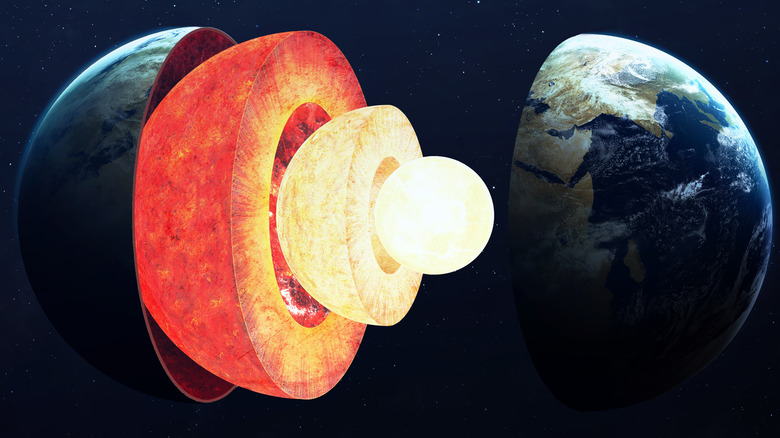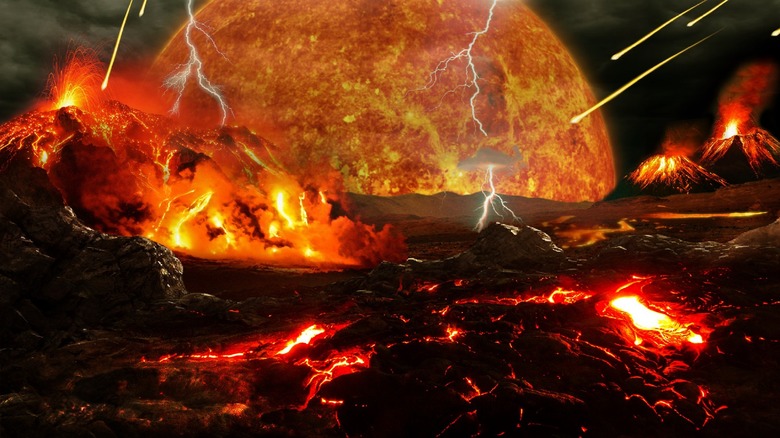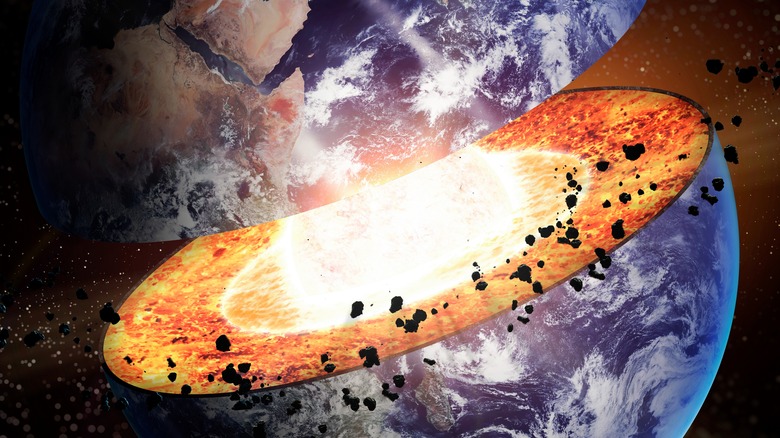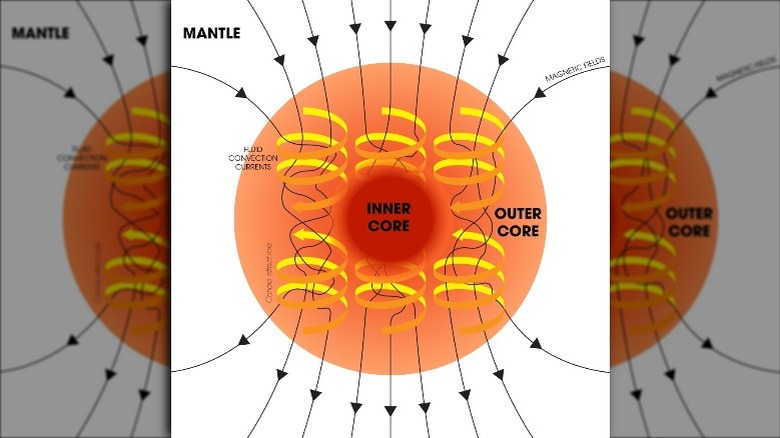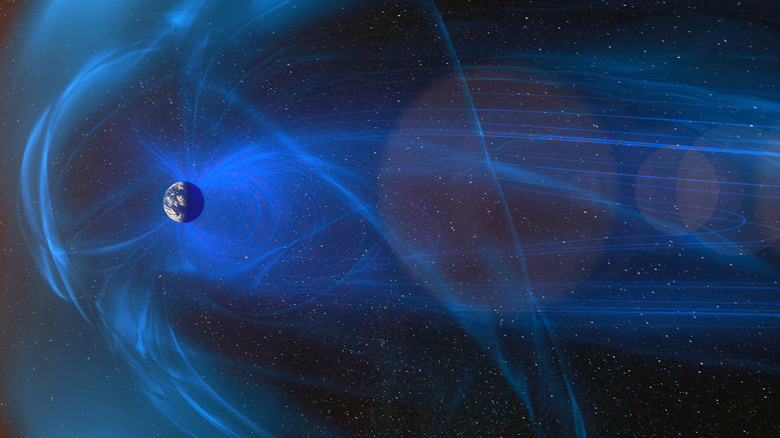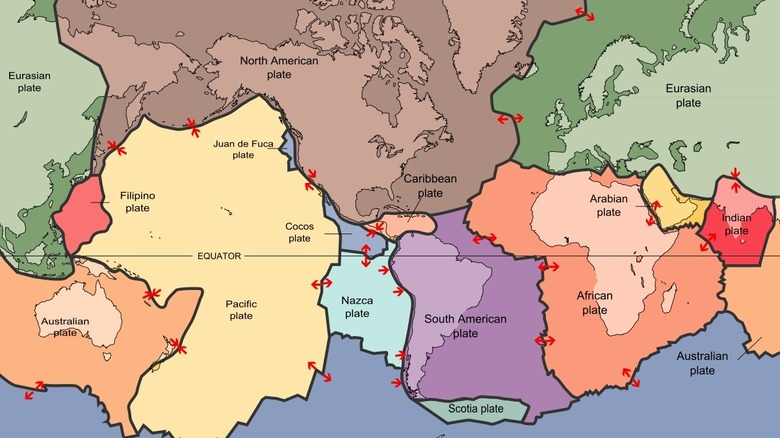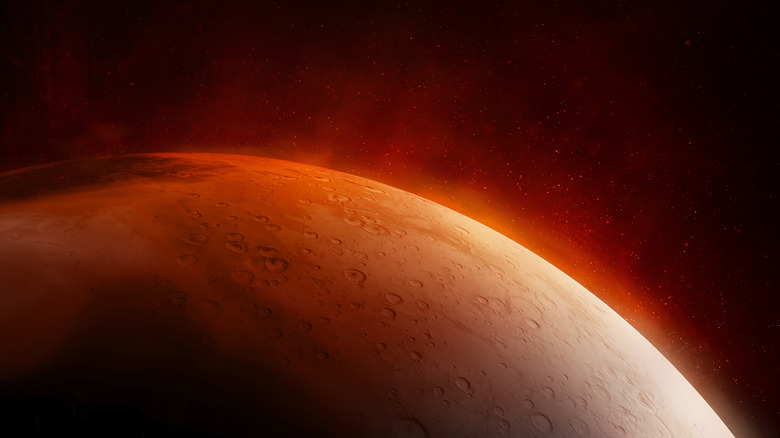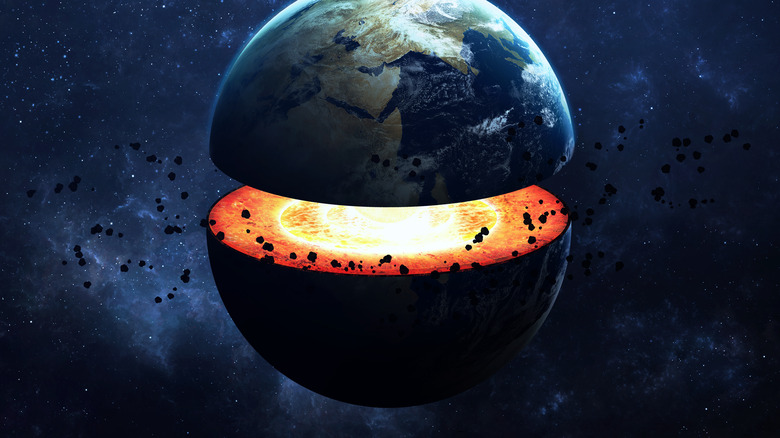What Would Happen If The Earth's Core Cooled
Despite the fact that humans have gone almost 250,000 miles away from Earth, they've never even managed to get 10 miles below the surface. And even though it's barely another 4,000 to the Earth's core, it's a greater mystery than some of the darkest parts of space.
There are several good reasons why it's ended up being easier to go into space than travel into the Earth. Even though space is considered to be quite cold, technically it doesn't have a temperature, since it's a vacuum. This means that even despite its lack of temperature, heat only travels by radiation which means that it takes more time to travel. And since space is a vacuum, there's no pressure to deal with of any kind, unless you find yourself in a black hole. But the closer you travel to the center of the Earth, the more gravity weighs upon you. This is also why deep sea exploration is considered more difficult than space exploration.
Scientists know that the Earth's core is hot, but they're still not quite sure exactly how hot, or even why it's so hot. But the immense heat at our planet's core is essential for life on this planet. So what would happen if the core cooled down? Would the planet remain habitable? And is it even possible for the Earth's core to cool down? Read on to find out.
What is the earth's core?
The Earth is made up of four basic layers: the crust, the mantle, the outer core, and the inner core. Even at its thickest point, the crust is less than 50 miles thick. The core lies at the center of the planet, roughly 1,800 miles through the mantle. But even at those immense depths, you've still only reached the outer core, which is itself almost 1,400 miles deep, according to National Geographic. And between the mantle and the outer core is a boundary that's known as the Gutenberg discontinuity.
According to EOS, the outer core is a liquid "rolling mass of molten metal" that surrounds the solid inner core. The inner core is found 3,200 miles below the surface of the Earth and is almost 1,550 miles wide, roughly the size of the Moon. For a while, it was believed that the Earth's core was a chunk of solid iron. But seismic measurements from as early as the 1950s suggested that it might contain more than just iron. The core is actually about 10% less dense than iron, and most likely also contains, in addition to other elements, nickel, silicon, and magnesium. Sulfur is also found in the core, and it's estimated that roughly 90% of the Earth's sulfur is located there.
And funnily enough, the current makeup of the core is actually younger than Earth itself, having formed between roughly half a billion and 1.5 billion years ago.
Why is the earth's core hot?
Although it's known that the Earth's core is incredibly hot, no one knows exactly how hot it is. And National Geographic writes that the temperatures are liable to shift based on the core elements, the Earth's rotation, and pressure. Despite this, scientists have some guesses as to how hot the Earth's core actually is. Scientists estimate that temperatures there fluctuate between almost 8,000° Fahrenheit to over 10,000° Fahrenheit. According to PHYS, with these temperatures, the Earth's core is even hotter than the surface of the sun, which is just about 10,000° Fahrenheit. But the highest temperatures actually occur at the Bullen discontinuity, which distinguishes the inner core from the outer core.
Scientific American reports that there are three main reasons that the Earth's core is so hot. There's the heat that comes from radioactive decay, the heat caused by differentiation, or the friction generated by heavy objects being pulled to the core, and the heat that's left over from the initial formation of the planet.
But in the end, scientists are unsure exactly how hot the Earth's core is. Not only is there still debate about what exactly the core is made out of, but it's incredibly difficult to do an experiment in the lab "that faithfully simulates conditions in the Earth's core." Scientists have come up with their current best estimates using lasers and high-pressure devices, but the exact melting point of iron at high pressures is still unknown.
The lopsided effect
Everyone considers the Earth to be a sphere, so it stands to reason that its inner core would be similarly spherical. But in fact, the Earth itself isn't even perfectly round. According to Scientific American, the Earth more closely resembles "a sphere that is squashed at its poles and swollen at the equator." The core is similarly squished but rather than growing in a uniform fashion, the core actually grows in a lopsided way.
According to The Print, the Earth's core, which is already growing slowly as it cools, turns out to grow more quickly on one side than the other. In 2021, new research suggested that the inner core is losing heat faster under Indonesia than it is under Brazil and that "quicker cooling on one side would accelerate iron crystallization and inner core growth on that side." However, due to the immense gravity at the center of the Earth, the growth of the core ends up being distributed so that its radial growth remains constant at 1 millimeter per year. Ultimately, it's unknown exactly why this cooling process happens faster under Indonesia than under Brazil. But Earth Sky writes that scientists believe that this process has been occurring ever since the Earth's core was formed.
And interestingly, it's possible that the rotation of the earth has an effect on the iron crystals in the core, which appear to be aligned along the rotation axis of the Earth, despite the fact that they would theoretically be randomly aligned.
Why might the earth's core cool down?
Despite being incredibly hot, the Earth's core is actually going through a constant process of melting and freezing. According to Gizmodo, when the tectonic plates move and one of the plates gets pushed underneath the other, a process known as subduction, the mantle ends up losing some heat. And as the plate sinks deeper and deeper into the mantle, it takes heat from the core as well.
But while this is happening, some of the other tectonic plates are actually creating more heat since they're so big that the mantle underneath them is "hotter than average." This heat also travels down to the core, but instead of cooling it down, it heats it up and reactivates the melting process.
However, according to The Conversation, despite this continuous process the Earth's core is ultimately cooling down, albeit incredibly slowly, as it's been doing ever since it formed. And as the core cools down, the inner core actually ends up growing, since solid iron has more volume than liquid iron. This means that every year, the inner core grows by about 1 millimeter. But even this cooling process gives off heat that "travels all the way to the Earth's crust through the process of convection." This type of cooling process likely won't affect life on the surface for billions of years, since it'll take over one million years for just one mile to cool down. But what if the core suddenly cooled down all at once?
Losing our magnetic field
If the core suddenly cooled down, one of the very first things that would happen is the loss of the planet's magnetic field. According to Cosmos Magazine, the magnetic field around the Earth is created by the outer core, which in addition to being liquid, is constantly rotating through "heat driven circulation." Known as the dynamo effect, this theory suggests the constant flow of metal in the outer core creates electric currents. And as the Earth rotates, these electric currents create a magnetic field that extends around the entire planet.
If the magnetic field around the planet disappears, not only will birds be unable to migrate and compasses will cease to point north, but all life on Earth will suddenly become more exposed to solar winds. While this doesn't mean the end of all life on the planet, it does mean much higher exposure to radiation, which can be dangerous to humans, but some animals withstand radiation better than others. Without a magnetic field, technical glitches will also become commonplace, since solar particles can cause interferences with high-frequency radio waves, according to Live Science.
The Earth's magnetic field is absolutely vital towards protecting the planet's atmosphere, but don't worry. While movies like "The Core" make it seem like the second the magnetic field falters that laser-like sun rays will burn the Golden Gate Bridge into two, the real effect wouldn't be as dramatic. Although if there happens to be a particularly bad solar flare, who knows?
Stopping the motion of the plates
Another effect of the Earth's core cooling down would be that the tectonic plates would cease moving. If the core cooled down, it would in turn cool down the mantle upon which the tectonic plates travel. But it isn't just the liquid mantle that moves the plates around. The heat from the core itself is also thought to move the Earth's plates.
UChicago News writes that scientists once believed that the Earth's plates moved because of the "negative buoyancy created as they cool." However, it's now believed that the plates move due to the heat that they draw from the Earth's core. According to Science Advances, scientists estimate that as much as 50% of the movement of the tectonic plates is driven by heat from the core. Without this heat, it's possible that Earth will become "a completed jigsaw of titanic slabs that will no longer drift or sink," writes National Geographic. Without moving plates, subduction will also cease to occur, and although there may be occasional earthquakes due to the crust melting off into the mantle, as the inside of the Earth cools, the outside would come to a virtual standstill.
And one important implication of this finding is the idea that if the heat coming from the core has an effect on the surface, then it's possible that there's even more heat stored in the core than previously believed.
Starting to look like Mars
If the Earth's core cooled, after some time our planet would begin to resemble some of the other planets in our solar system. As the crust melts into the mantle slowly, the minor earthquakes and "additional pockets of volcanism" would start to make Earth's surface resemble that of Venus, according to National Geographic.
As everything slowly comes to a grinding halt and the lack of a magnetic field causes solar winds to irradiate and microwave the planet, the surface of the planet would start to resemble Mercury. But according to Space, it's more likely that the planet would end up looking like Mars, which itself once had shifting tectonic plates that were likely similar to the ones on Earth now.
Because Mars never had its own magnetic field, or if it did it faded out extremely early, its outer layer was always vulnerable to solar winds. And as the planet cooled, its plates also became stationary, resulting in the planet's stagnant and rocky surface. However, the planet may not actually be as motionless as initially thought. According to Science Daily, in 2012 scientists discovered that there are likely active faults on Mars, but it's unclear if they are actually active more than once every million years. And while some scientists believe that the movement could come from magma or water underneath the surface, others think that it's due to the planet's "ongoing cooling and contraction."
How long till the earth's core cools?
Ultimately, nothing lasts forever, and the Earth's core is included in that. And ever since the core formed between half a billion and 1.5 billion years ago, it's been steadily cooling, even if it's at an infinitesimally slow rate.
According to Interesting Engineering, since most of the heat at the Earth's core is released through radioactive decay, the core will likely stay warm for longer than if most of the heat was primordial, meaning "residual heat from the formation of Earth." But even with all of these heat sources fading, it's still going to be a very long time before the Earth's core cools down naturally, with estimates ranging from tens of billions of years to upwards to 90 billion years from now. Luckily, since the Sun's likely going to burn out in around 5 billion years, according to Space, the Earth won't even be around to see its core fade away.
Could we heat the earth's core back up?
If the core suddenly cooled down, would it even be possible for humans to do anything about it? The movie "The Core" makes it seem doable, but in reality, traveling to the Earth's core is insanely difficult.
From the surface of the Earth to the center is a distance of about 4,000 miles. And according to Scientific American, the deepest hole ever dug by humans only goes down about 7.5 miles. Known as the Kola Superdeep Borehole, the hole took almost 20 years to dig and was meant to go "as deep as possible," which the scientists estimated would be about 9 miles. But after the team encountered rocks at 356° Fahrenheit, they were unable to go any further, since "this was almost twice as hot as they'd predicted."
But even if the core suddenly cooled down to the point of being able to travel through it, temperature isn't the only thing keeping humans away from the center of the Earth. Spring8 writes that the pressure at the center of the Earth measures at around 364 GPa (Gigapascals). In comparison, atmospheric pressure on the Earth's surface is around 101325 Pa (pascal). This means that the pressure at the Earth's core is almost 3.5 million times higher than surface pressure. Even the pressure at the bottom of the ocean is only 1,000 times higher than surface pressure, so going to the center of the Earth would really be one high pressure situation.
What else could happen to the earth's core?
Although it's unlikely that the Earth's core is going to cool down anytime soon, that doesn't mean that it'll quietly keep chugging along until it's time to fade away. Over the years, scientists have actually discovered that the core may be leaking into the mantle, and it may have been leaking for billions of years.
While the inner core is estimated to be at most 1.5 billion years old, since it's estimated that the magnetic field "already existed three billion years ago," according to Science Focus, it's likely that there was some semblance of the outer core already at play. And in 2019, scientists started to realize that the core may have been interacting with the mantle earlier than once assumed and leaking tungsten isotopes into the mantle, reports EOS.
And in 2020, Science Alert writes that scientists also discovered that the core might also be leaking iron into the mantle. However, no one really knows what such a leak means or how long it's been occurring for. All anyone knows is that "a leak from the core to the mantle under high temperature and pressure is possible, and it could explain why mantle rocks hold so much more iron than meteorites." But whether or not this leak will have any negative effects in the future is unknown, and if the leak got bigger, humans probably wouldn't be able to do much about it.
